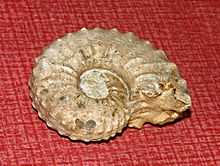Acanthoceras (ammonite)
|
Acanthoceras Temporal range: Albian-Coniacian ~109.0–89.3 Ma |
|
|---|---|
 |
|
| Fossil of A. rhotomagensis from France, on display at Galerie de paléontologie et d'anatomie comparée in Paris | |
| Scientific classification | |
| Kingdom: | Animalia |
| Phylum: | Mollusca |
| Class: | Cephalopoda |
| Subclass: | †Ammonoidea |
| Order: | †Ammonitida |
| Family: | †Acanthoceratidae |
| Subfamily: | †Acanthoceratinae |
| Genus: |
†Acanthoceras Neumayr, 1875 |
| Species | |
|
See text |
|
See text
Acanthoceras is an extinct cephalopod genus belonging to the subclass Ammonoidea and family Acanthoceratidae that lived from the Albian to Early Coniacian stages of the Cretaceous.
Their shells had ornate ribs whose function is unknown, although some scientists have speculated that these ribs helped strengthen the animals' shells to allow them to live at greater depths where the water pressure is higher. An adult had a shell diameter of approximately 100 centimetres (39 in).
Acanthoceras fossils have been found in Australia, Brazil, Bulgaria, Colombia (Hondita Formation, Prado, Tolima), Denmark, Egypt, France, Germany, Iran, Madagascar, Mexico, Mozambique, Nigeria, Papua New Guinea, Peru, the United Kingdom, United States (California, Minnesota, New Mexico, Texas), and Venezuela.
...
Wikipedia
